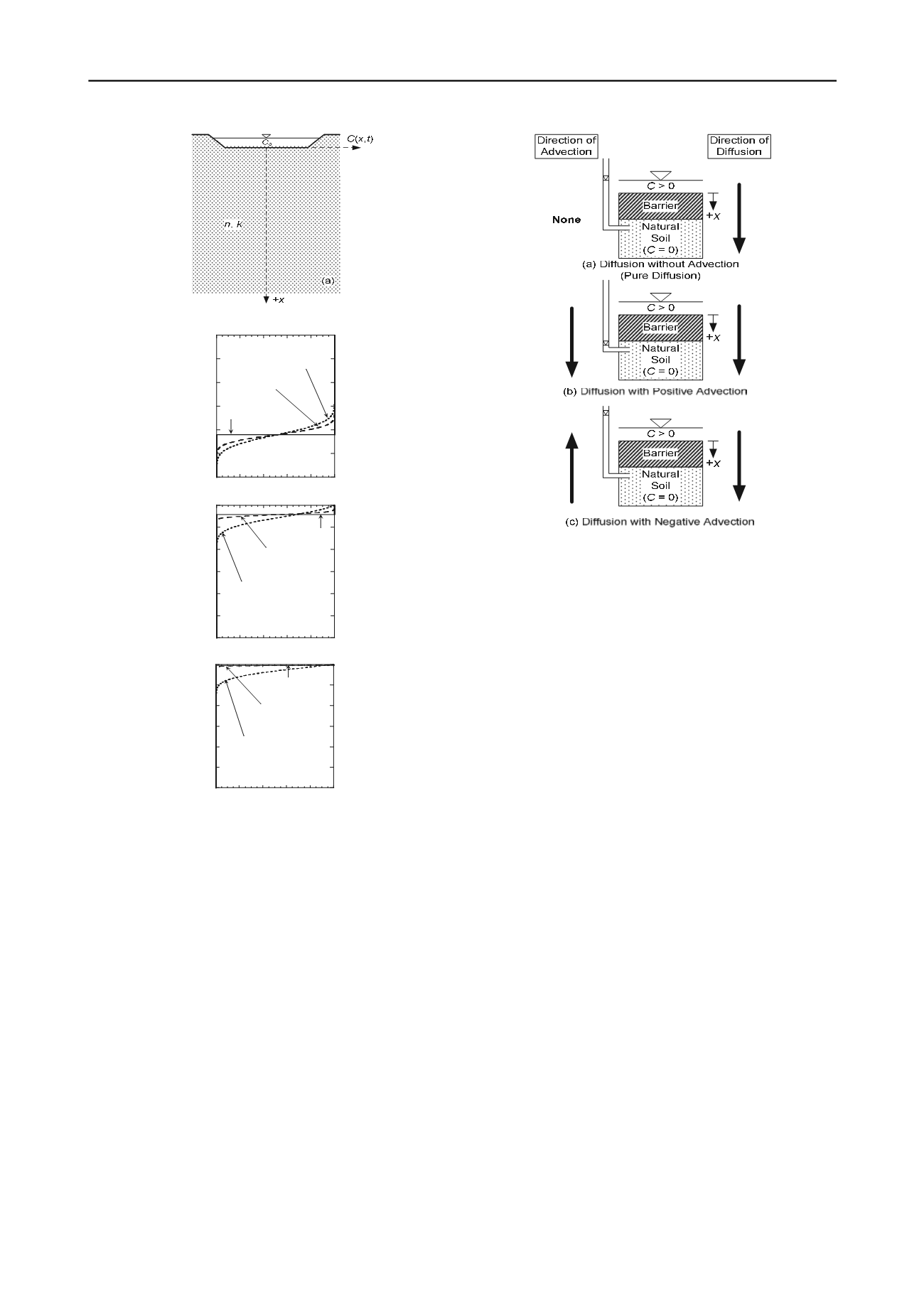
131
Honour Lectures /
Conférences honorifiques
5
0
1
2
3
4
5
6
0 0.2 0.4 0.6 0.8 1
(b )
Depth (m)
R elative C oncen tration,
C
(
x
,
t
)/
C
o
k
h
= 10
-8
m /s
P ure
A dvection
A dvectio n
+
M echanical
D ispersion
A dvection
+
Diffusio n
0
1
2
3
4
5
6
0 0.2 0 .4 0.6 0 .8 1
(c )
Depth (m)
R e lative C o ncen tration ,
C
(
x
,
t
)/
C
o
k
h
= 1 0
-9
m /s
P ure
A dvectio n
A dvectio n
+
M ec ha nica l
D isp ers io n
A dvectio n
+
D iffusio n
0
1
2
3
4
5
6
0 0 .2 0 .4 0 .6 0 .8 1
(d )
Depth (m)
R e la tiv e C o n c e n tra tio n ,
C
(
x
,
t
)/
C
o
k
h
= 1 0
-10
m /s
P u re
A d v e c tio n
A d v e c tio n
+
M e c h a n ic a l
D is p e rs io n
A d v e c tio n
+
D iffu s io n
Figure 2. Representative concentration profiles beneath a ponded
source of liquid after an elapsed time of 5 yr: (a) schematic of
scenario (
n
= 0.5,
D
*
= 6 x 10
-10
m
2
/s,
i
h
= 1.33); (b) advective
dominated case; (c) diffusive significant case; (d) diffusive
dominated case.
The most common scenario is illustrated in Fig. 3b,
where both hydraulic and concentration gradients act in the
same direction to drive advective and diffusive chemical
transport from the containment side of the barrier to the
surrounding medium. This scenario also is the scenario
depicted previously with respect to Figs. 1 and 2.
Figure 3. Transport scenarios across horizontal barriers for waste
containment: (a) pure diffusion; (b) diffusion with positive
(outward) advection; (c) diffusion with negative (inward)
advection (modified after Shackelford 1989, 1993).
The third scenario (Fig. 3c) pertains to the case where
the hydraulic and concentration gradients act in opposite
directions, such that advective transport is directed inward
towards the containment side of the barrier, whereas
diffusive transport still is directed outward. As a result, the
net outward advance of the chemicals is slowed or
"retarded" by the opposing hydraulically driven transport.
This situation would arise, for example, when the
containment system is located at a site with a high
groundwater table, such as a perched water table, such that
the barrier is located below the water table. This scenario
has been referred to as "zone of saturation" containment
(e.g. Shackelford 1989, 1993). The scenario also has been
referred to as a "hydraulic trap," because the inward
directed hydraulic gradient enhances the containment
function (e.g., Rowe et al. 2000, Badv and Abdolalizadeh
2004). However, because diffusion is still prevalent, the
existence of an opposing hydraulic gradient does not
necessarily mean that no contaminant will escape
containment, as the net effect will depend on the
magnitude of advective transport relative to that for
diffusive transport. Also, the effectiveness of inward
gradient landfills may not be as complete as expected in
the case where the barrier possesses semipermeable
membrane properties (Whitworth and Ghazifard 2009).
4.2
Diffusion through Barriers or Barrier Components
4.2.1
Diffusion in Natural Clays
The recognition that diffusion may play an important role
in governing contaminant migration gained momentum in
the late 1970s with the publication of a case study by
Goodall and Quigley (1977) describing the field
concentration profiles that existed beneath two landfill
sites near Sarnia, Ontario, Canada, viz. the Confederation
Road landfill and the Blackwell Road landfill. The pore
water obtained from Shelby tube samples collected beneath
a landfill sited directly on top of intact glacial till, and the


